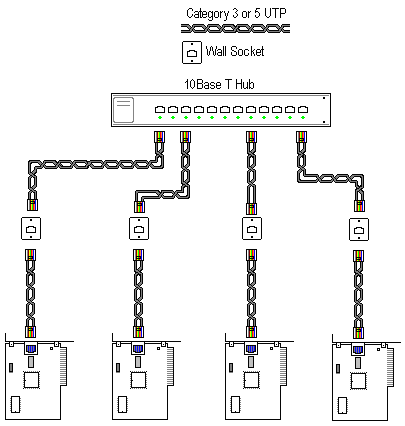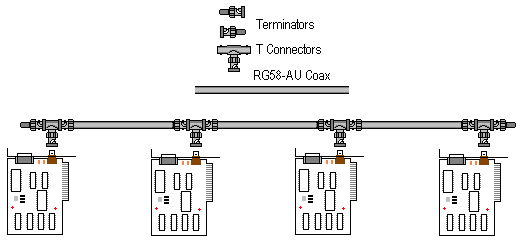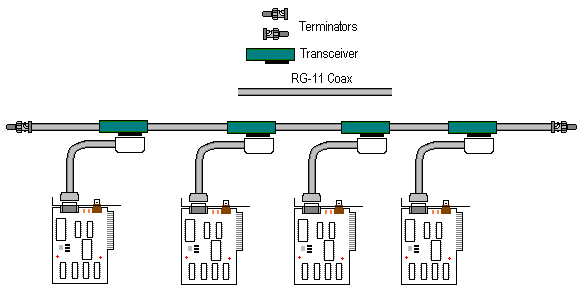Ethernet
- Baseband signaling.
- Linear or star-bus topology.
- Usually transmits at 10 Mbps with 100 Mbps possible.
- Uses CSMA/CD for traffic regulation.
- IEEE specification 802.3.
- Uses thicknet, thinnet or UTP cabling
- Media is passive => it draws power from the computer
Ethernet Frames
Ethernet breaks data into frames. A frame can be from 64 to 1,518 bytes long
in total. The ethernet frame itself takes up 18 bytes, so the actual data can
be from 46 to 1,500 bytes.
- Preamble: marks the start of a frame.
- Destination and Source: addressing information.
- Type: Identifies network layer protocol.
- CRC: error checking data.
10Base-T
- (10 = 10 Mbps; Base= Baseband; T = Twisted Pair)
- 10 Mbps, baseband over UTP.
- Usually wired in a physical star with a hub or multiport repeater.
Internally it uses a bus signaling system like other Ethernet configurations
- Maximum segment length 100 meters (328 feet).
- Minimum between computers 2.5 meters (8 feet).
- 1024 nodes maximum on the LAN
- Category 3, 4 or 5 UTP.
- RJ-45 connectors, 4 twisted pair.
- Coaxial or Fiber backbone for larger LAN's
10BaseT UTP NETWORK LAYOUT
Limitations
- maximum segment length of 100 Meters
- Hub to Hub or repeater to repeater links limited to 100 Meters
Rules
- star topology
- 4 repeater/5 segment rule of 10Base5 is retained
- only two nodes per segment are allowed
Cabling
- RJ-45 Connectors
- Category 3 UTP minimum, preferably Category 5

10Base-2
- (10 = 10 Mbps; Base= Baseband; 2 = 2x 100 meters)
- 10 Mbps, baseband over thinnet.
- Uses bus topology.
- Maximum segment length 185 meters (607 feet).
- Minimum between computers 0.5 meters (20 inches).
- Maximum of 30 computers per segment.
- Obeys 5-4-3 rule: Five segments, joined by four repeaters, 3 populated
giving a total length of 925 meters (3035 feet).
Physical Bus Cable Limits
10Base2 THIN ETHERNET NETWORK LAYOUT
Limitations
- maximum number of trunk segments = 5
- maximum trunk segment length = 607 feet (185 meters)
- maximum network trunk cable = 3035 feet (925 meters)
- maximum number of stations on a trunk segment = 30
- minimum distance between T connectors = 1.5 feet (0.5 meters)
Rules
- each end of the trunk segment is terminated in 50-ohms
- one of the terminators is grounded
- connector splices are kept to a minimum
Cabling
- BNC-T type connectors
- RG58-AU 50-ohm cable, 0.2"
- Note that you can't mix RG58 /AU and RG58 /U cable on the same network.

10Base-5
- (10 = 10 Mbps; Base= Baseband; 5 = 5 x 100 meters)
- 10 Mbps, baseband over thicknet.
- Also called Standard Ethernet
- Designed to support a backbone for a large department or building. Transceivers
attach to the thicknet cable and the cable AUI connector plugs into a repeater
. The branching segments of thinnet plug into the repeater and connect to
the computers on the network.
- Uses bus topology.
- Maximum segment length 500 meters.
- Minimum between transceivers 2.5 meters (8 feet)
- 100 computers per segment, 300 per network.
- Obeys 5-4-3 rule: maximum distance can be extended to 2500 meters
(8200 ft) using 4 repeaters and 3 populated segments.
- Transceiver is attached to main segment with a vampire tap.
- DIX or AUI connector is used to attach the transceiver to the network
card. Maximum computer to transceiver distance is 50 meters. This distance
is not included in the 5-4-3 calculation.

10Base-5 Summary
| Maximum segment length |
- 500m (1640 ft)
- Typically used as backbone to connect Thinnet-based network.
|
| Speed |
10 Mbps |
| Maximum taps |
100 |
| Maximum segments |
|
| Maximum repeaters |
|
| Maximum segment with nodes |
- 3
- Due to attenuation, only 3 of 5 segments can actually contain network
connection. Other 2 segments can be used to connect the network over
long distance.
|
| Maximum nodes per segment |
100 |
| Maximum nodes for network |
300 |
| Minimum distance between nodes |
2.5m (8 ft) |
| Maximum overall length with repeaters |
2.5 km |
| Maximum AUI drop cable length |
50m |
- 10Base-F?
- (10 = 10 Mbps; Base= Baseband; FL =fibre optic)
- Allows long cable runs between repeaters, like between buildings
- Maximum segment length 2000 meters.
- 10BaseFL - Used for linking computers in a LAN environment.
- 10BaseFP - Used for linking computers with passive hubs from
maximum cable distance up to 500m
- 10BaseFB - Used as a backbone between hubs.
- Baseband signal over a fiber-optic cable.
- Need concentrator (fiber-optic hub) ® Star wired (star topology)
. Either active or passive
- Long distance.
- Very expensive. Difficult to install.
Maximum segment length - 2000m
Maximum segments- 1024
Maximum segment with nodes- 1024
Maximum nodes per segment- 1
Maximum nodes per network- 1024
Maximum hubs in a chain- 4
- 100VG-AnyLAN (IEEE 802.12)
- 100 Mbps data rate.
- Star topology over Category 3, 4 and 5 UTP.
- Uses demand priority access.
- Combines element of traditional Ethernet and Token Ring and supports Ethernet
and token ring packets.
- Faster than Ethernet
- Demand priority access method => two priority levels, low and
high
- Intelligent hubs can filter individually addressed frames for enhanced
privacy.
- Expensive
- Uses RJ-45.
- Cable - require 4 pairs wire
- Categories 3, 4 UTP- 100m
- Category 5 UTP - 150m
- Fiber-optic- 2000m
- Uses star topology and defines how child hub can be connected to
a parent hub to extend the network.
Minimum length between nodes - 2.5m
Maximum segments- 1024
Maximum nodes per segment- 1
Maximum nodes for network- 1024
- 100BaseT? (Fast Ethernet)
- Uses CSMA/CD on a star-wired bus.
- There are 3 specifications:
- 100BaseT4: Uses pair category 3, 4 or 5 UTP.
- 100BaseTX: Uses 2-pair category 5 UTP or STP.
- 100BaseFX: Uses 2-strand fiber-optic.
Ethernet 802.2 - NetWare 3.12 and 4.x - IEEE 802.3 standard compliance.
Includes field in Ethernet 802.3 and LLC (Logical Link Control)
Ethernet 802.3 - NetWare 3.11 and before
Includes CRC
Ethernet SNAP (SubNetwork Address Protocol) - AppleTalk
Ethernet II - TCP/IP
Segmentation
- Can be performed with bridges or routers.
- Reduces traffic on network segments to increase performance.
- IEEE 802.5 specification.
- Star wired ring topology (logical ring)
- Uses token passing access method.
- Can have higher transmission speeds than Ethernet
- It has larger frames than Ethernet => more can get transferred over the
wire in any given time.
- Uses IBM STP Types 1, 2 and 3 cabling. (Can be UTP)
- Transmits at 4 and 16 Mbps. (16 Mbps cards will slow down to 4 Mbps if put
on that kind of network, but the 4 Mbps cards can't speed up.
- Baseband transmission
- Data travels in one direction only
- Each computer acts as a unidirectional repeater
- Deterministic method of cable access. Computers cannot use the cable unless
they have the token. Therefore, computers can't force their way onto the network
like CSMA/CD (Ethernet)
- First computer online is assigned to monitor network activity.
Token Ring Components
- Multistation Access Units (MAU's)
- Multistation Access Units (MSAU's)
- Smart Multistation Access Units (SMAU's)
- Computers attach directly to the MSAU in a physical star to form a logical
ring.
- Each MSAU has 10 connection ports ==> can support 8 clients with
2 ports for ring in and ring out.
- Each ring can have as many as 33 MSAU's
- 70 computers with UTP
- 260 computers with STP.
- Up to 12 MSAU's can connect to each other
- The MSAU can sense if a computer is down and then disconnect it from the
ring => built-in fault tolerance
- Cabling
- Most token ring systems use IBM type 3 cabling.
- STP or UTP to a hub, IBM type 1,2,3 cable
- Type 1: 101m from MSAU to PC
- STP: 100m from MSAU to PC
- UTP: 45m from MSAU to PC
- Type 3: 150 feet from MSAU to PC
- Token ring networks are well suited to fiber optic cable: data travels
in only one direction in it.
Here are some limitations of Token Ring:
- The maximum number of workstations is 260 on Type 1 or fiber optic cable
at 16 Mbps.
- The maximum number of workstations is 72 on Type 3 cable at 4 Mbps.
- The distance between MSAUs (Multistation Access Units) is 100 meters (Type
1 cabling) to 45 meters (Type 2 cabling).
- Each ring can have up to 33 MSAUs.
- Maximum distance of the ring is 4 kilometers with fiber optic cable.
Token Ring and Ethernet Comparison
Token Ring
- can have higher transmission speeds than Ethernet
- supports more computers on a single segment (up to 260)
- more expensive than Ethernet
- harder to install than Ethernet
- is more fault tolerant because of the beaconing process
- local talk
- CSMA/CA access method
- 3 things happen when devices attached
- device assigns itself an address randomly
- device broadcasts the address to see if it's used
- if not, the device will use it the next time it's online again
- bus or tree
- STP
- max. 32 devices
- Apple share
- file server on an AppleTalk network
- divided into zones
- EtherTalk
- 802.3
- allows protocols to run on ethernet coaxial cable
- TokenTalk
- 802.5
- allows Macintosh to connect to token ring network
- IEEE 802.4 specification - almost
- Cable
- Uses RG-62 (93 ohm) (most common)or
- RG-59 (75ohm) coaxial cable.
- Can also use UTP.
- Uses token passing on a star-bus topology.
- Token moves from computer to computer in numerical order.
- Transmits at 2.5 Mbps.
- ArcNet plus - 20 Mbps
- connected by cable to hub
- 93 ohm RG-62 A/U - 610m max., star
- 93 ohm RG-62 A/U - 305m max., bus <= notice less distance on hub
- RJ-11, RJ-45 UTP - max. 244m on star or bus
- Hubs can be
- Passive => merely relay signal
- Active => regenerate and relay signal
- Smart => add diagnostic features, such as reconfiguration detection
Here are some limitations of ARCNet:
- Bus segment length for coaxial cable is a maximum of 1000 feet, with a limit
of 8 workstations per coaxial segment.
- Bus segment length for twisted pair is a maximum of 400 feet, with a limit
of 10 workstations per twisted-pair segment.
- There is a maximum of 255 workstations per network.
- Workstations can be located up to 600 feet from the active hub.
- The maximum distance from passive hubs to active hubs is 100 feet; the maximum
distance between two active hubs is 2000 feet.
- The maximum distance allowed between workstations is 20,000 feet.
- There can be no more than four workstations on a passive hub, no more than
100 feet from a hub.
- Passive hubs cannot be connected to other passive hubs.
 Comments and suggestions? E-mail me at
grantwilson21@yahoo.com
Comments and suggestions? E-mail me at
grantwilson21@yahoo.com
I'm sorry, but I can't answer specific network-related, or exam-related questions. |
| Last Updated: August 6, 2001 |
Grant Wilson, Edmonton, AB
Canada |


